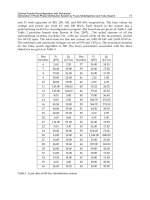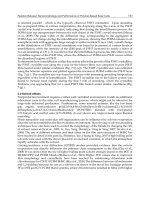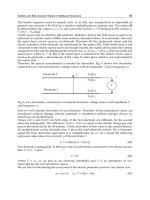Code of Standard Practice for Steel Buildings and Bridges Part 5 docx
Bạn đang xem bản rút gọn của tài liệu. Xem và tải ngay bản đầy đủ của tài liệu tại đây (60.08 KB, 9 trang )
choose to make CAD files or copies of the Design Drawings avail-
able to the Fabricator, and may charge a service or licensing fee for
this convenience. In doing so, a carefully negotiated agreement
should be established to set out the specific responsibilities of both
parties in view of the liabilities involved for both parties. For a
sample contract, see CASE Document 11.
The CAD files and/or copies of the Design Drawings are
provided to the Fabricator for convenience only. The information
therein should be adapted for use only in reference to the placement
of Structural Steel members during erection. The Fabricator should
treat this information as if it were fully produced by the Fabricator
and undertake the same level of checking and quality assurance.
When amendments or revisions are made to the Contract
Documents, the Fabricator must update this reference material.
When CAD files or copies of the Design Drawings are pro-
vided to the Fabricator, they often contain other information, such
as architectural backgrounds or references to other Contract
Documents. This additional material should be removed when pro-
ducing Shop and Erection Drawings to avoid the potential for con-
fusion.
4.4. Approval
Except as provided in Section 4.5, the Shop and Erection Drawings
shall be submitted to the Owner’s Designated Representatives for
Design and Construction for review and approval. These drawings
shall be returned to the Fabricator within 14 calendar days.
Approved Shop and Erection Drawings shall be individually anno-
tated by the Owner’s Designated Representatives for Design and
Construction as either approved or approved subject to corrections
noted. When so required, the Fabricator shall subsequently make
the corrections noted and furnish corrected Shop and Erection
Drawings to the Owner’s Designated Representatives for Design
and Construction.
Commentary:
As used in this Code, the 14-day allotment for the return of Shop
and Erection Drawings is intended to represent the Fabricator’s
portal-to-portal time. The intent in this Code is that, in the absence
Code of Standard Practice for Steel Buildings and Bridges, March 7, 2000
AMERICAN INSTITUTE OF STEEL CONSTRUCTION
23
of information to the contrary in the Contract Documents, 14 days
may be assumed for the purposes of bidding, contracting and
scheduling. A submittal schedule is commonly used to facilitate the
approval process.
4.4.1. Approval of the Shop and Erection Drawings, approval subject to
corrections noted and similar approvals shall constitute the follow-
ing:
(a) Confirmation that the Fabricator has correctly interpreted the
Contract Documents in the preparation of those submittals;
(b) Confirmation that the Owner’s Designated Representative for
Design has reviewed and approved the Connection details
shown on the Shop and Erection Drawings and submitted in
accordance with Section 3.1.2, if applicable; and,
(c) Release by the Owner’s Designated Representatives for Design
and Construction for the Fabricator to begin fabrication using
the approved submittals.
Such approval shall not relieve the Fabricator of the responsibility
for either the accuracy of the detailed dimensions in the Shop and
Erection Drawings or the general fit-up of parts that are to be
assembled in the field.
The Fabricator shall determine the fabrication schedule that
is necessary to meet the requirements of the contract.
Commentary:
When considering the current language in this Section, the
Committee sought language that would parallel the practices of
CASE. In CASE Document 962, CASE indicates that when the
design of some element of the primary structural system is left to
someone other than the Structural Engineer of Record, “…such ele-
ments, including connections designed by others, should be
reviewed by the Structural Engineer of Record. He [or she] should
review such designs and details, accept or reject them and be
responsible for their effects on the primary structural system.”
Historically, this Code has embraced this same concept.
From the inception of this Code, AISC and the industry in
Code of Standard Practice for Steel Buildings and Bridges, March 7, 2000
AMERICAN INSTITUTE OF STEEL CONSTRUCTION
24
general have recognized that only the Owner’s Designated
Representative for Design has all the information necessary to eval-
uate the total impact of Connection details on the overall structural
design of the project. This authority has traditionally been exer-
cised during the approval process for Shop and Erection Drawings.
The Owner’s Designated Representative for Design has thus
retained responsibility for the adequacy and safety of the entire
structure since at least the 1927 edition of this Code.
4.4.2. Unless otherwise noted, any additions, deletions or revisions that
are indicated on the approved Shop and Erection Drawings shall
constitute authorization by the Owner that the additions, deletions
or revisions are Released for Construction. The Fabricator and the
Erector shall promptly notify the Owner’s Designated
Representative for Construction when any direction or notation on
the Shop or Erection Drawings or other information will result in
an additional cost and/or a delay. See Sections 3.5 and 9.3.
Commentary:
When the Fabricator notifies the Owner’s Designated
Representative for Construction that a direction or notation on the
Shop or Erection Drawings will result in an additional cost or a
delay, it is then normally the responsibility of the Owner’s
Designated Representative for Construction to subsequently notify
the Owner’s Designated Representative for Design.
4.5. Shop and/or Erection Drawings Not Furnished by the
Fabricator
When the Shop and Erection Drawings are not prepared by the
Fabricator, but are furnished by others, they shall be delivered to
the Fabricator in a timely manner. These Shop and Erection
Drawings shall be prepared, insofar as is practical, in accordance
with the shop fabrication and detailing standards of the Fabricator.
The Fabricator shall neither be responsible for the completeness or
accuracy of Shop and Erection Drawings so furnished, nor for the
general fit-up of the members that are fabricated from them.
Code of Standard Practice for Steel Buildings and Bridges, March 7, 2000
AMERICAN INSTITUTE OF STEEL CONSTRUCTION
25
SECTION 5. MATERIALS
5.1. Mill Materials
Unless otherwise noted in the Contract Documents, the Fabricator
is permitted to order the materials that are necessary for fabrication
when the Fabricator receives Contract Documents that have been
Released for Construction.
Commentary:
The Fabricator may purchase materials in stock lengths, exact
lengths or multiples of exact lengths to suit the dimensions shown
in the structural Design Drawings. Such purchases will normally be
job-specific in nature and may not suitable for use on other projects
or returned for full credit if subsequent design changes make these
materials unsuitable for their originally intended use. The
Fabricator should be paid for these materials upon delivery from
the mill, subject to appropriate additional payment or credit if sub-
sequent unanticipated modification or reorder is required.
Purchasing materials to exact lengths is not considered fabrication.
5.1.1. Unless otherwise specified by means of special testing require-
ments in the Contract Documents, mill testing shall be limited to
those tests that are required for the material in the ASTM specifi-
cations indicated in the Contract Documents. Certified mill test
reports shall be furnished by the Fabricator if requested to do so by
the Owner’s Designated Representative for Design, either in the
Contract Documents or in separate written instructions given to the
Fabricator prior to ordering Mill Materials.
Commentary:
Mill tests are performed to demonstrate material conformance to
ASTM specifications in accordance with the contract requirements.
5.1.2. When Mill Material does not satisfy ASTM A6/A6M tolerances for
camber, profile, flatness or sweep, the Fabricator shall be permitted
to perform corrective procedures, including the use of controlled
heating and/or mechanical straightening, subject to the limitations
in the AISC Specification.
Code of Standard Practice for Steel Buildings and Bridges, March 7, 2000
AMERICAN INSTITUTE OF STEEL CONSTRUCTION
26
Commentary:
Mill dimensional tolerances are completely set forth in ASTM
A6/A6M. Normal variations in the cross-sectional geometry of
Standard Structural Shapes must be recognized by the designer, the
Fabricator, the Steel Detailer and the Erector (for example, see
Figure C–5.1). Such tolerances are mandatory because roll wear,
thermal distortions of the hot cross-section immediately after leav-
ing the forming rolls and differential cooling distortions that take
place on the cooling beds are all unavoidable. Geometric perfection
of the cross-section is not necessary for either structural or archi-
tectural reasons, if the tolerances are recognized and provided for.
ASTM A6/A6M also stipulates tolerances for straightness
that are adequate for typical construction. However, these charac-
teristics may be controlled or corrected to closer tolerances during
the fabrication process when the added cost is justified by the spe-
cial requirements for an atypical project.
5.1.3. When variations that exceed ASTM A6/A6M tolerances are dis-
covered or occur after the receipt of Mill Material the Fabricator
shall, at the Fabricator’s option, be permitted to perform the ASTM
A6/A6M corrective procedures for mill reconditioning of the sur-
face of Structural Steel shapes and plates.
5.1.4. When special tolerances that are more restrictive than those in
ASTM A6/A6M are required for Mill Materials, such special toler-
ances shall be specified in the Contract Documents. The Fabricator
shall, at the Fabricator’s option, be permitted to order material to
ASTM A6/A6M tolerances and subsequently perform the correc-
tive procedures described in Sections 5.1.2 and 5.1.3.
5.2. Stock Materials
5.2.1. If used for structural purposes, materials that are taken from stock
by the Fabricator shall be of a quality that is at least equal to that
required in the ASTM specifications indicated in the Contract
Documents.
5.2.2. Certified mill test reports shall be accepted as sufficient record of
the quality of materials taken from stock by the Fabricator. The
Code of Standard Practice for Steel Buildings and Bridges, March 7, 2000
AMERICAN INSTITUTE OF STEEL CONSTRUCTION
27
Code of Standard Practice for Steel Buildings and Bridges, March 7, 2000
AMERICAN INSTITUTE OF STEEL CONSTRUCTION
28
Figure C-5.1. Mill tolerances on the cross-section of a W-shape.
Fabricator shall review and retain the certified mill test reports that
cover such stock materials. However, the Fabricator need not main-
tain records that identify individual pieces of stock material against
individual certified mill test reports, provided the Fabricator pur-
chases stock materials that meet the requirements for material
grade and quality in the applicable ASTM specifications.
5.2.3. Stock materials that are purchased under no particular specifica-
tion, under a specification that is less rigorous than the applicable
ASTM specifications or without certified mill test reports or other
recognized test reports shall not be used without the approval of the
Owner’s Designated Representative for Design.
Code of Standard Practice for Steel Buildings and Bridges, March 7, 2000
AMERICAN INSTITUTE OF STEEL CONSTRUCTION
29
SECTION 6. SHOP FABRICATION AND DELIVERY
6.1. Identification of Material
6.1.1. Material that is ordered to special requirements shall be marked by
the supplier as specified in ASTM A6/A6M Section 12 prior to
delivery to the Fabricator’s shop or other point of use. Material that
is ordered to special requirements, but not so marked by the sup-
plier, shall not be used until:
(a) Its identification is established by means of testing in accor-
dance with the applicable ASTM specifications; and,
(b) A Fabricator’s identification mark, as described in Section 6.1.2
and 6.1.3, has been applied.
6.1.2. During fabrication, up to the point of assembling members, each
piece of material that is ordered to special requirements shall carry
a Fabricator’s identification mark or an original supplier’s identifi-
cation mark. The Fabricator’s identification mark shall be in accor-
dance with the Fabricator’s established identification system,
which shall be on record and available prior to the start of fabrica-
tion for the information of the Owner’s Designated Representative
for Construction, the building-code authority and the Inspector.
6.1.3. Members that are made of material that is ordered to special
requirements shall not be given the same assembling or erection
mark as members made of other material, even if they are of iden-
tical dimensions and detail.
6.2. Preparation of Material
6.2.1. The thermal cutting of Structural Steel by hand-guided or mechan-
ically guided means is permitted.
6.2.2. Surfaces that are specified as “finished” in the Contract Documents
shall have a roughness height value measured in accordance with
ANSI/ASME B46.1 that is equal to or less than 500. The use of any
fabricating technique that produces such a finish is permitted.
Code of Standard Practice for Steel Buildings and Bridges, March 7, 2000
AMERICAN INSTITUTE OF STEEL CONSTRUCTION
30
Commentary:
Most cutting processes, including friction sawing and cold sawing,
and milling processes meet a surface roughness limitation of 500
per ANSI/ASME B46.1.
6.3. Fitting and Fastening
6.3.1. Projecting elements of Connection materials need not be straight-
ened in the connecting plane, subject to the limitations in the AISC
Specification.
6.3.2. Backing bars and runoff tabs shall be used in accordance with AWS
D1.1 as required to produce sound welds. The Fabricator or Erector
need not remove backing bars or runoff tabs unless such removal is
specified in the Contract Documents. When the removal of backing
bars is specified in the Contract Documents, such removal shall
meet the requirements in AWS D1.1. When the removal of runoff
tabs is specified in the Contract Documents, hand flame-cutting
close to the edge of the finished member with no further finishing
is permitted, unless other finishing is specified in the Contract
Documents.
Commentary:
In most cases, the treatment of backing bars and runoff tabs is left
to the discretion of the Owner’s Designated Representative for
Design. In some cases, treatment beyond the basic cases described
in this Section may be required. As one example, special treatment
is required for backing bars and runoff tabs in beam-to-column
moment Connections when the requirements in the AISC Seismic
Provisions must be met. In all cases, the Owner’s Designated
Representative for Design should specify the required treatments in
the Contract Documents.
6.3.3. Unless otherwise noted in the Shop Drawings, high-strength bolts
for shop-attached Connection material shall be installed in the shop
in accordance with the requirements in the AISC Specification.
Code of Standard Practice for Steel Buildings and Bridges, March 7, 2000
AMERICAN INSTITUTE OF STEEL CONSTRUCTION
31









